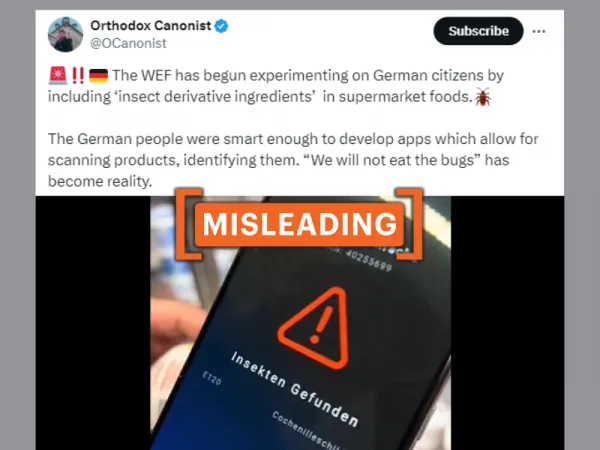By: Siri Christiansen
April 30 2024
No, the WEF has not hidden insects in food products

Source: X/Screenshot (Modified by Logically Facts)
The Verdict Misleading
Shellac and carmine have been used in food products for several years and have not recently been introduced by the WEF or the German government.
The claim
A video from a German supermarket is going viral on X (formerly Twitter) and Facebook. It shows a person using their phone to scan the barcode of several food items, including yogurt, egg salad, and cookies. Their phone then displays a warning triangle and text that says "insect found."
Social media users claim that this app has been developed by "the German people" in response to the World Economic Forum (WEF) recently putting insect-derived ingredients in supermarket foods to "experiment on German citizens." Other users claim that German food manufacturers are the culprits. One X post has gained over three million views in 24 hours. Archived posts can be found here and here.
The facts
The video can be traced back to the TikTok account of the Insect Food Scanner app, which has posted several videos showing how its app works. On the App Store website, the Insekten Scanner Pro app markets itself by referring to new EU regulations that allow companies to add ground insects to foods as a protein source and that consumers, by purchasing the app, can easily identify these foods. The Insect Food Scanner is currently the second most popular paid food and drink app in the App Store.
A closer look at the food items scanned in the viral video shows that none of them contain novel insect powder but rather contain additives that have already been around for decades.
Two of the products in the video contain E904, shellac, a glossy coating that is derived from lac insects, and the remaining products contain E120, carmine, a pigment derived from cochineal insects. A common misconception is that these additives are made up of grounded insects, but this is not the case. Shellac is made up of the resinous secretion that the female lac insect produces as it feeds. It is possible that traces of the insect bodies could remain after the food processing, but the amount has been deemed insignificant by experts speaking to AFP. While carmine is indeed derived from crushed cochineal insects, the pigment foods has been separated and extracted from the insoluble insect bodies. The amount of actual insect bodies remaining has been deemed "minuscule."
What's more, these additives have not been introduced by the WEF or the German government. The use of carmine as a color additive in human food was approved by the U.S. Food and Drug Administration back in 2009, and shellac was approved as an additive in the Codex Alimentarius, a collection of international food standards, codes of practices, and guidelines, in 2001.
"These additives have been around for a very long time," a government inspector at the Swedish Food Agency told Logically Facts.
The idea that insect-derived additives would have been smuggled to food products in secret also doesn't hold ground, the inspector added, since most additives have to be included in the ingredient list.
"If an additive has an E number, it simply means it has been approved by the EU, and the point of the E number system is to have a shared labeling system throughout the union," the government inspector added. "True, it doesn't say it is derived from insects, but there is readily available information to explain what the E numbers stand for. Companies also have the option to print the name of the additive instead of its E number."
Finally, the EU does not allow food companies or the WEF to hide grounded-up insects in food products. Regulations from 2021 and 2023 state that insect-based ingredients must be listed on the product packaging by their scientific and everyday names. Such products must also feature a warning that they could cause an allergic reaction.
The verdict
Shellac and carmine have been used in food products for several years and have not recently been introduced by the WEF or the German government. Therefore, we have marked this claim as misleading.


